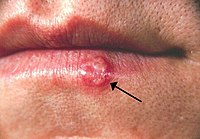
Photo from wikipedia
BACKGROUND Alphaherpesvirus belongs to the Herpesviridae family and has large, monopartite double-stranded linear DNA. It mainly infects the skin, mucosa, and nerves, and can affect various hosts, including humans and… Click to show full abstract
BACKGROUND Alphaherpesvirus belongs to the Herpesviridae family and has large, monopartite double-stranded linear DNA. It mainly infects the skin, mucosa, and nerves, and can affect various hosts, including humans and other animals. Here, we present a case of a patient seen by the gastroenterology department at our hospital who experienced an oral and perioral herpes infection following treatment with a ventilator. The patient was treated with oral and topical antiviral drugs, furacilin, oral and topical antibiotics, local epinephrine injection, topical thrombin powder, and nutritional and supportive care. A wet wound healing approach was also implemented with good response. CASE SUMMARY A 73-year-old woman presented to the hospital with a chief complaint of "abdominal pain for 3 d with dizziness for 2 d." She was admitted to the intensive care unit for septic shock and spontaneous peritonitis secondary to cirrhosis and was given antiinflammatory and symptomatic supportive treatment. A ventilator was used to assist breathing for acute respiratory distress syndrome, which developed during her admission. A large area of herpes infection appeared in the perioral region 2 d following noninvasive ventilation. The patient was transferred to the gastroenterology department, at which time she had a body temperature of 37.8 C and a respiratory rate of 18/min. The patient's consciousness was intact, and she no longer had abdominal pain or distension, chest tightness, or asthma. At this point, the infected perioral region changed in appearance and was now accompanied by local bleeding with crusting of blood at the wounds. The surface area of the wounds measured approximately 10 cm × 10 cm. A cluster blisters appeared on the patient’s right neck, and ulcers developed in her mouth. On a subjective numerical pain scale, the patient reported a pain level of 2. Overall, her diagnoses other than the oral and perioral herpes infection included: (1) Septic shock; (2) spontaneous peritonitis; (3) abdominal infection; (4) decompensated cirrhosis; and (5) hypoproteinemia. Dermatology was consulted regarding the treatment of the patient’s wounds; they suggested treatment with oral antiviral drugs, an intramuscular injection of nutritious nerve drugs, and the application of topical penciclovir and mupirocin around the lips. Stomatology was also consulted and suggested the use of nitrocilin in a local wet application around the lips. CONCLUSION Through multidisciplinary consultation, the patient’s oral and perioral herpes infection was successfully treated with the following combined approach: (1) Application of topical antviral and antibiotic treatments; (2) keeping the wound moist with a wet wound healing strategy; (3) systemic use of oral antiviral drugs; and (4) symptomatic and nutritional supportive care. The patient was discharged from the hospital after successful wound healing.
Journal Title: World Journal of Clinical Cases
Year Published: 2023
Link to full text (if available)
Share on Social Media: Sign Up to like & get
recommendations!